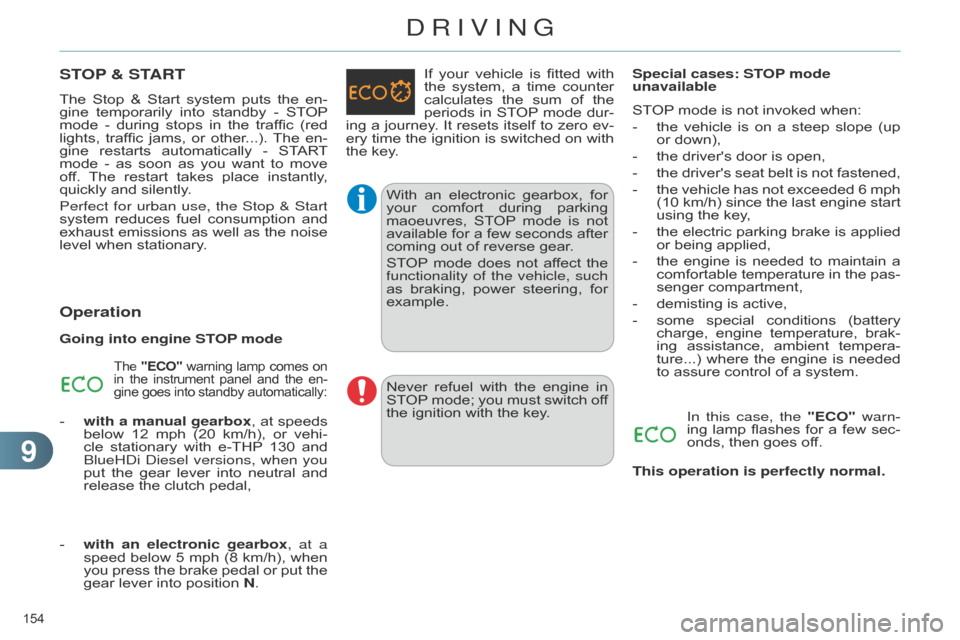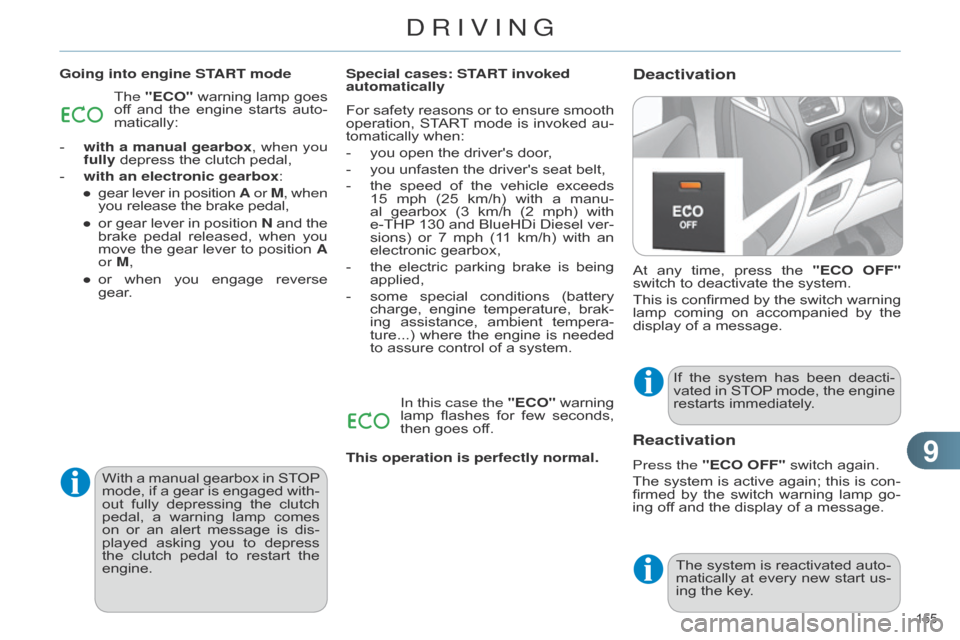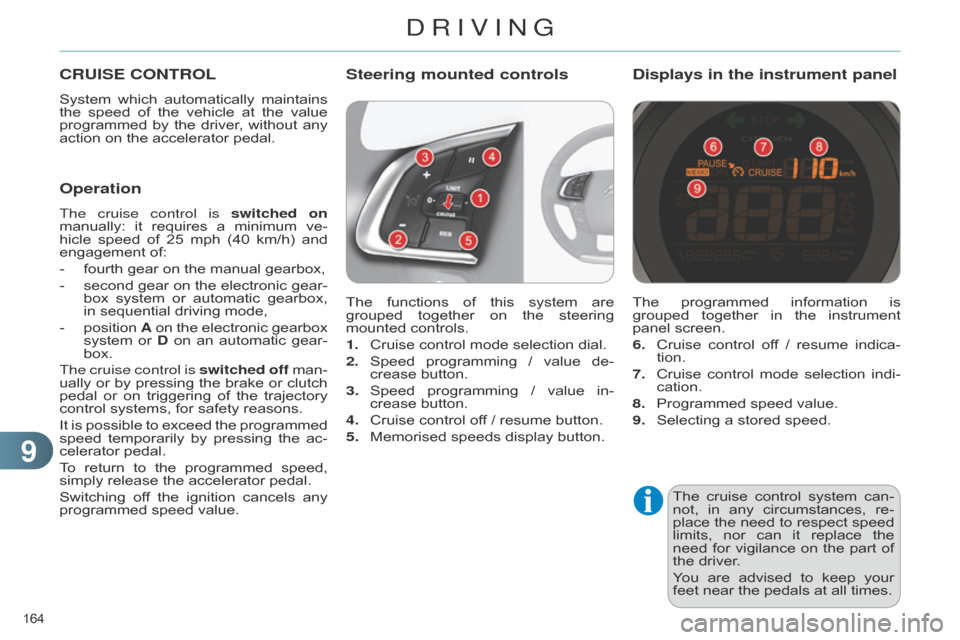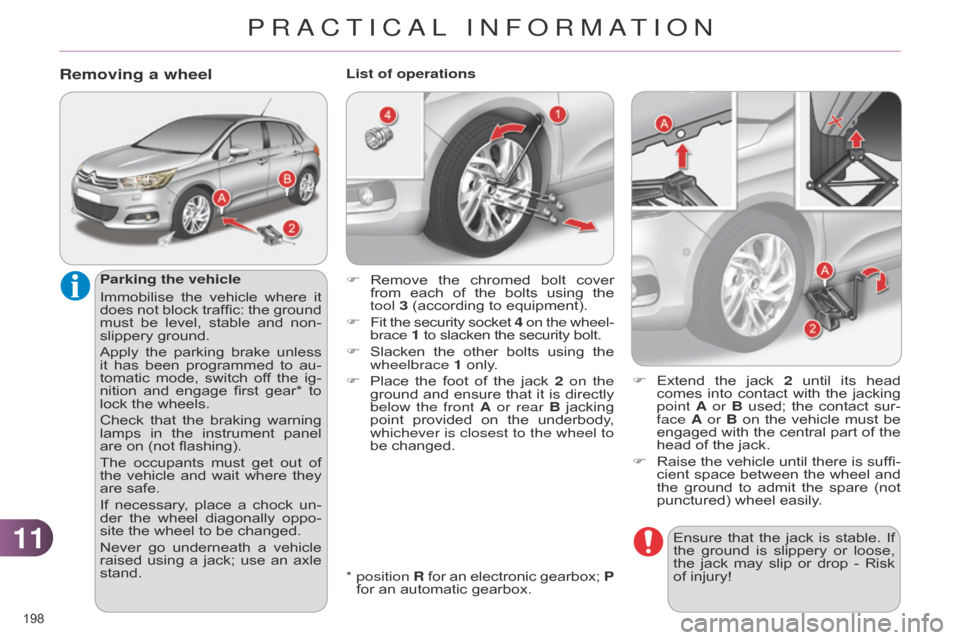gearbox Citroen C4 DAG 2014.5 2.G Owner's Guide
[x] Cancel search | Manufacturer: CITROEN, Model Year: 2014.5, Model line: C4 DAG, Model: Citroen C4 DAG 2014.5 2.GPages: 340, PDF Size: 12.89 MB
Page 156 of 340

99
154
C4-2_en_Chap09_conduite_ed01-2014
STOP & START
The Stop & Start system puts the en -
gine temporarily into standby - ST OP mode
-
during
stops
in
the
traffic
(red
lights,
traffic
jams,
or
other
...).
The
en
-
gine
restarts
automatically
-
ST
ART
mode
-
as
soon
as
you
want
to
move
of
f.
The
restart
takes
place
instantly
,
quickly
and silently.
Perfect for urban use, the Stop & Start
system
reduces
fuel
consumption
and
exhaust
emissions
as
well
as
the
noise
level
when stationary.
Operation
Going into engine STOP mode
The "ECO" warning lamp comes on in
the instrument panel and the en -
gine
goes into standby automatically:
- with a manual gearbox, at speeds below
12 mph (20 km/h), or vehi -
cle
stationary
with
e-THP 130
and
b
lueH d i
d
iesel versions, when you
put
the
gear
lever
into
neutral
and
release
the clutch pedal, If
your
vehicle
is
fitted
with
the
system,
a
time
counter
calculates
the
sum
of
the
periods
in
ST
OP
mode
dur
-
ing
a
journey
.
It
resets
itself
to
zero
ev
-
ery
time
the
ignition
is
switched
on
with
the
key.
-
with
an electronic gearbox, at a
speed
below
5
mph
(8
km/h),
when
you
press
the
brake
pedal
or
put
the
gear
lever into position N.With
an
electronic
gearbox,
for
your
comfort
during
parking
maoeuvres,
ST
OP
mode
is
not
available
for
a
few
seconds
after
coming
out of reverse gear.
STOP
mode
does
not
af
fect
the
functionality of the vehicle, such
as
braking,
power
steering,
for
example.Special cases: ST
OP mode
unavailable
STOP
mode is not invoked when:
-
the
vehicle
is
on
a
steep
slope
(up
or
down),
-
the
driver's door is open,
-
the
driver's
seat
belt
is
not
fastened,
-
the
vehicle
has
not
exceeded
6
mph
(10
km/h)
since
the
last
engine
start
using
the key,
-
the
electric
parking
brake
is
applied
or
being applied,
-
the
engine
is
needed
to
maintain
a
comfortable
temperature
in
the
pas
-
senger compartment,
-
demisting
is active,
-
some
special
conditions
(battery
charge,
engine
temperature,
brak
-
ing
assistance,
ambient
tempera
-
ture...)
where
the
engine
is
needed
to
assure control of a system.
In this case, the "ECO" warn-
ing lamp flashes for a few sec -
onds,
then goes off.
Never
refuel
with
the
engine
in
ST
OP
mode;
you
must
switch
of
f the
ignition with the key.
This operation is perfectly normal.
DRIVING
Page 157 of 340

99
155
C4-2_en_Chap09_conduite_ed01-2014
DeactivationGoing into engine START modeAt
any
time,
press
the
"ECO OFF"
switch
to deactivate the system.
This
is
confirmed
by
the
switch
warning
lamp
coming
on
accompanied
by
the
display
of a message.
Special cases: START invoked
automatically
If
the
system
has
been
deacti
-
vated
in
ST
OP
mode,
the
engine
restarts
immediately.
The
"ECO"
warning
lamp
goes
of
f
and
the
engine
starts
auto
-
matically:
-
with a manual gearbox
, when you
fully
depress the clutch pedal,
-
with an electronic gearbox
:
●
gear
lever
in
position
A or
M, when
you
release the brake pedal,
●
or
gear
lever
in
position
N
and
the
brake
pedal
released,
when
you
move
the
gear
lever
to
position
A
or M,
●
or
when
you
engage
reverse
gear
. For
safety
reasons
or
to
ensure
smooth
operation,
ST
ART
mode
is
invoked
au
-
tomatically
when:
-
you
open the driver's door,
-
you
unfasten the driver's seat belt,
-
the
speed
of
the
vehicle
exceeds
15
mph
(25
km/h)
with
a
manu
-
al
gearbox
(3
km/h
(2
mph)
with
e-THP 130
and
BlueHDi
Diesel
ver
-
sions)
or
7
mph
(1
1
km/h)
with
an
electronic
gearbox,
-
the
electric
parking
brake
is
being
applied,
-
some
special
conditions
(battery
charge,
engine
temperature,
brak
-
ing
assistance,
ambient
tempera
-
ture...)
where
the
engine
is
needed
to
assure control of a system.
In this case the "ECO"
warning
lamp
flashes
for
few
seconds,
then
goes off.
With
a
manual
gearbox
in
ST
OP
mode,
if
a
gear
is
engaged
with
-
out
fully
depressing
the
clutch
pedal,
a
warning
lamp
comes
on
or
an
alert
message
is
dis
-
played
asking
you
to
depress
the
clutch
pedal
to
restart
the
engine.
Reactivation
Press the "ECO OFF" switch again.
The
system
is
active
again;
this
is
con
-
firmed
by
the
switch
warning
lamp
go
-
ing
off and the display of a message.
The
system
is
reactivated
auto
-
matically
at
every
new
start
us
-
ing
the key.
This operation is perfectly normal.
DRIVING
Page 166 of 340

99
164
C4-2_en_Chap09_conduite_ed01-2014
The cruise control system can -
not, in any circumstances, re -
place
the
need
to
respect
speed
limits,
nor
can
it
replace
the
need
for
vigilance
on
the
part
of
the
driver.
You
are
advised
to
keep
your
feet
near the pedals at all times.
CRUISE CONTROL
System which automatically maintains the
speed of the vehicle at the value
programmed
by
the
driver
,
without
any
action
on the accelerator pedal.
The
functions
of
this
system
are
grouped
together
on
the
steering
mounted
controls.
1.
Cruise
control mode selection dial.
2.
Speed
programming
/
value
de
-
crease
button.
3.
Speed
programming
/
value
in
-
crease
button.
4.
Cruise
control off / resume button.
5.
Memorised
speeds display button.
Steering mounted controls
The programmed information is grouped
together in the instrument
panel
screen.
6.
Cruise
control
of
f
/
resume
indica
-
tion.
7.
Cruise
control
mode
selection
indi
-
cation.
8.
Programmed
speed value.
9.
Selecting
a stored speed.
Displays in the instrument panel
Operation
The cruise control is switched on
manually: it requires a minimum ve -
hicle
speed
of
25
mph
(40
km/h)
and
engagement
of:
-
fourth
gear on the manual gearbox,
-
second
gear
on
the
electronic
gear
-
box
system
or
automatic
gearbox,
in
sequential driving mode,
-
position
A
on
the
electronic
gearbox
system
or
D
on
an
automatic
gear
-
box.
The cruise control is switched off
man
-
ually
or
by
pressing
the
brake
or
clutch
pedal
or
on
triggering
of
the
trajectory
control
systems, for safety reasons.
It
is
possible
to
exceed
the
programmed
speed
temporarily
by
pressing
the
ac
-
celerator
pedal.
To
return
to
the
programmed
speed,
simply
release the accelerator pedal.
Switching
of
f
the
ignition
cancels
any
programmed
speed value.
DRIVING
Page 184 of 340

1010
182
C4-2_en_Chap10_verification_ed01-2014
Automatic gearbox
The gearbox does not re -
quire any maintenance (no oil
change).
Refer
to
the
manufacturer's
service
schedule
for
details
of
the
level
checking
interval
for
this
component.
Electric parking brake
This system does not require any
routine servicing. However ,
in
the
event
of
a
problem,
have
the
system
checked
by
a
CITROËN
dealer
or
a
qualified
work
-
shop.
Manual parking brake
Only use products recommended by
CITROËN or products of equiva -
lent
quality and specification.
In order to optimise the opera -
tion of units as important as
those
in
the
braking
system,
CITROËN
selects
and
of
fers
very
specific products.
After
washing
the
vehicle,
damp
-
ness,
or
in
wintry
conditions,
ice
can
form
on
the
brake
discs
and
pads:
braking
efficiency
may
be
reduced.
Make
light
brake
ap
-
plications
to
dry
and
defrost
the
brakes.
If a loss of ef
fectiveness of this
system
is
noticed,
the
parking
brake
must
be
checked,
even
between
two
services.
Checking
this
system
must
be
done
by
a
CITROËN
dealer
or
a
quali
-
fied
workshop.
Brake pads
Brake wear depends on the style
of driving, particularly in
the
case
of
vehicles
used
in
town,
over
short
distances.
It
may
be
necessary
to
have
the
condition
of
the
brakes
checked,
even
between
vehicle services.
Unless
there
is
a
leak
in
the
circuit,
a
drop
in
the
brake
fluid
level
indicates
that
the
brake pads are worn.
Brake disc wear
For information on checking brake
disc wear , contact a
CITROËN
dealer
or
a
quali
-
fied
workshop. For
more
information,
refer
to
the
"Electric parking
brake - Operating faults" section.
Manual gearbox
The gearbox
does not re -
quire any maintenance (no oil
change).
Refer
to
the
manufacturer's
service
schedule
for
the
checking
interval
for
this
com
-
ponent.
Electronic gearbox
The gearbox does not re -
quire any maintenance (no oil
change).
Refer
to
the
manufacturer's
service
schedule
for
details
of
the
checking
interval
for
this
component.
CHECKS
Page 200 of 340

1111
198
C4-2_en_Chap11_info-pratique_ed01-2014
Ensure that the jack is stable. If the
ground is slippery or loose,
the
jack
may
slip
or
drop
-
Risk
of
injury!
Removing a wheel
Parking the vehicle
Immobilise
the
vehicle
where
it
does
not
block
traffic:
the
ground
must
be
level,
stable
and
non-
slippery
ground.
Apply
the
parking
brake
unless
it
has
been
programmed
to
au
-
tomatic
mode,
switch
of
f
the
ig
-
nition
and
engage
first
gear*
to
lock
the wheels.
Check
that
the
braking
warning
lamps
in
the
instrument
panel
are
on (not flashing).
The
occupants
must
get
out
of
the
vehicle
and
wait
where
they
are
safe.
If
necessary
,
place
a
chock
un
-
der
the
wheel
diagonally
oppo
-
site
the wheel to be changed.
Never
go
underneath
a
vehicle
raised
using
a
jack;
use
an
axle
stand. *
position R
for
an
electronic
gearbox;
P
for
an automatic gearbox.
List of operations
F
Extend
the
jack
2
until
its
head
comes
into
contact
with
the
jacking
point A
or B
used;
the
contact
sur
-
face A or B
on
the
vehicle
must
be
engaged
with
the
central
part
of
the
head
of the jack.
F
Raise
the
vehicle
until
there
is
suffi
-
cient
space
between
the
wheel
and
the
ground
to
admit
the
spare
(not
punctured)
wheel easily.
F
Remove the chromed bolt cover from
each of the bolts using the
tool
3 (according to equipment).
F
Fit
the
security
socket
4 on the wheel
-
brace 1
to slacken the security bolt.
F
Slacken
the
other
bolts
using
the
wheelbrace
1 only.
F
Place
the
foot
of
the
jack
2
on the
ground
and
ensure
that
it
is
directly
below the front
A or rear B
jacking
point
provided
on
the
underbody
,
whichever is closest to the wheel to
be
changed.
PRACTICAL INFORMATION
Page 216 of 340

1111
214
C4-2_en_Chap11_info-pratique_ed01-2014
Charging the battery using
a battery chargerIt is advisable to disconnect the battery if the vehicle is to be left
unused
for more than one month.
The
batteries
contain
harmful
substances
such as sulphuric
acid
and
lead.
They
must
be
disposed
of
in
accordance
with
regulations
and
must
not,
in
any
circumstances,
be
discarded
with
household
waste.
Take
used
remote
control
bat
-
teries
and
vehicle
batteries
to
a
special
collection
point.
F
Disconnect the battery from the vehicle.
F Follow the instructions for use pro -
vided by the manufacturer of the
charger
.
F
Connect
the
battery
starting
with
the
negative
terminal (-).
F
Check
that
the
terminals
and
con
-
nectors
are
clean.
If
they
are
covered with
sulphate
(whitish
or
greenish
deposit),
remove
them
and
clean
them. Protect
your
eyes
and
face
be
-
fore handling the battery.
a
ll operations on the battery
must be carried out in a well ventilated
area and away from naked
flames and sources of
sparks,
so
as
to
avoid
the
risk
of
explosion
or fire.
Do
not
try
to
charge
a
frozen
battery;
the
battery
must
first
be
thawed
out
to
avoid
the
risk
of
explosion.
If
the
battery
has
been
frozen,
before
charging
have
it
checked
by
a
CITROËN
dealer
or
a
qualified
workshop
who
will
check
that
the
inter
-
nal
components
have
not
been
damaged
and
the
casing
is
not
cracked,
which
could
cause
a
leak
of toxic and corrosive acid.
Do
not
reverse
the
polarity
and
use
only a 12 V charger.
Do
not
disconnect
the
terminals
while
the engine is running.
Do
not
charge
the
batteries
with
-
out
disconnecting
the
terminals
first.
W
ash your hands afterwards.
Reinitialisation after
reconnection
after any reconnection of the battery,
switch on the ignition and wait at least
one
minute
before
starting,
to
allow
time
for
the initialisation of the
electronic
systems.
By
referring
to
the
corresponding
sec
-
tions,
you
should
set
or
initialise
the
fol
-
lowing
systems yourself:
-
one-touch
electric windows,
-
time
and date,
-
audio
and
navigation
system
set
-
tings.
Check
that
no
alert
message
or
warning
lamp
comes
on
after
switching
on
the
ignition.
However
,
if
minor
problems
persist
after
carrying
out
these
operations,
contact
a
CITROËN
dealer
or
a
quali
-
fied
workshop. Some
functions
are
not
available
if
the
battery
is
not
sufficiently
charged.
d
o not push the vehicle to start
the
engine
if
you
have
an
elec
-
tronic
or automatic gearbox.
With Stop & Start, the battery
does
not
have
to
be
disconnect
-
ed
for charging.
PRACTICAL INFORMATION
Page 219 of 340

1111
217
C4-2_en_Chap11_info-pratique_ed01-2014
TOWING THE VEHICLE
Procedure for having your vehicle towed
or for towing another vehicle us -
ing
a removable towing eye.
The
towing
eye
is
installed
in
the
boot
under
the floor.
To
gain access to it:
F
open the boot,
F
raise
the floor,
F
secure
it
by
hooking
its
cord
on
the
hook
on
the
rear
parcel
shelf
support,
F
remove
the
towing
eye
from
the
holder
.
Access to the tools General recommendations
Observe the legislation in force in your country.
Ensure
that
the
weight
of
the
towing
vehicle
is
higher
than
that
of
the
towed
vehicle.
The
driver
must
remain
at
the
wheel
of
the
towed
vehicle
and
must
have
a
valid
driving licence.
When
towing
a
vehicle
with
all
four
wheels
on
the
ground,
always
use
an
approved
towing arm; rope and straps are prohibited.
The
towing vehicle must move off gently.
When
towing
a
vehicle
with
the
engine
of
f,
there
is
no
longer
any
power
assistance
for braking or steering.
In
the
following
cases,
you
must
always
call
on
a
professional
recovery
service:
-
vehicle
broken down on a motorway or fast road,
-
four-wheel
drive vehicle,
-
when
it
is
not
possible
to
put
the
gearbox
into
neutral,
unlock
the
steering,
or release the parking brake,
-
towing
with only two wheels on the ground,
-
where
there is no approved towing arm available...
PRACTICAL INFORMATION
Page 220 of 340

1111
218
C4-2_en_Chap11_info-pratique_ed01-2014
F On the front bumper , unclip the cover by
pressing at the bottom.
F
Screw
the towing eye in fully.
F
Install
the towing bar.
Towing your vehicle
F Place the gear lever in neu -
tral (position N on an elec-
tronic
or automatic gearbox).
Failure to observe this in
-
struction
could
result
in
dam
-
age
to
certain
components
(braking,
transmission...)
and
the
absence
of
braking
as
-
sistance
the
next
time
the
engine
is started. F
On
the
rear
bumper
,
unclip
the
cover by
pressing at the bottom.
F
Screw
the towing eye in fully.
F
Install
the towing bar.
F
Switch
on
the
hazard
warning
lamps
on
both vehicles.
F
Move
of
f
gently
,
drive
slowly
and
for
a
short distance.
Towing another vehicle
F Unlock the steering by turning the key
in the ignition one notch and re -
lease
the parking brake.
F
Switch
on
the
hazard
warning
lamps
on
both vehicles.
F
Move
of
f
gently
,
drive
slowly
and
for
a
short distance.
PRACTICAL INFORMATION
Page 225 of 340

223
C4-2_en_Chap12_caracteristique_ed01-2014
* The maximum power corresponds to the value type-approved on a test bed, under conditions defined in European legisla -
tion (Directive 1999/99/EC).
PETROL ENGINES AND GEARBOXES
.../1: model fitted with low rolling resistance tyres.
.../2: model fitted with very low rolling resistance tyres.
Petrol engine
VTi 95THP 110 VTi 120
Gearbox Manual
(5-speed) Manual
(5-speed) Manual
(5-speed) Automatic
(4-speed)
Model code:
NC... 8FR0HNZ6
HNZ6/1
HNZ6/2 5FS0
5FS9
5FS9/D
Cubic capacity (cc) 1 397
1 199
1 598
Bore x stroke (mm)
77 x 72.5 75 x 90.5
77 x 85.8
Max power*: EU standard (kW)
7081 88
Max power engine speed (rpm)
6 000
5 500
6 000
Max torque: EU standard (Nm)
135205 160
Max torque engine speed (rpm)
4 000
1 500
4 250
Fuel Unleaded Unleaded Unleaded
Catalytic converter Ye sYe s Ye s
Engine oil capacity (in litres) 4.25- 4.25
12
TECHNICAL DATA
Page 226 of 340

224
C4-2_en_Chap12_caracteristique_ed01-2014
* The maximum power corresponds to the value type-approved on a test bed, under conditions defined in European legisla -
tion (Directive 1999/99/EC).
.../S:
model fitted with Stop & Start.
.../1: model
fitted with low rolling resistance tyres.
Petrol engine
e-THP 130THP 155
Gearbox Manual
(6-speed) Electronic
(6-speed)
Model code:
NC... HNYM/S
HNYM/1S 5FV8/P
Cubic capacity (cc) 1 199
1 598
Bore x stroke (mm)
70 x 90.5
77 x 85.8
Max power*: EU standard (kW)
96 11 5
Max power engine speed (rpm)
5 500
6 000
Max torque: EU standard (Nm)
230 240
Max torque engine speed (rpm)
1 750
1 400
Fuel UnleadedUnleaded
Catalytic converter Ye sYe s
Engine oil capacity (in litres) -4,25
12
TECHNICAL DATA